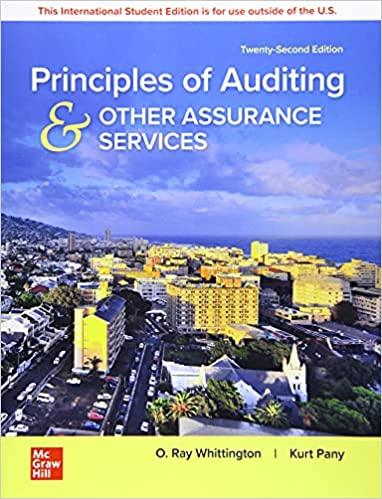Answered step by step
Verified Expert Solution
Question
1 Approved Answer
Chapati Company started business on January 1, 2020. Some of the events that occurred in its first year of operations follow: Transactions 1. An insurance
Chapati Company started business on January 1, 2020. Some of the events that occurred in its first year of operations follow:
| Transactions | |
| 1. | An insurance policy was purchased on February 28 for $1,980. The insurance policy was for one year of coverage that began on March 1, 2020. |
| 2. | During the year, inventory costing $136,000 was purchased, all on account. |
| 3. | Sales to customers totalled $200,000. Of these, $40,000 were cash sales. |
| 4. | Payments to suppliers for inventory that had been purchased earlier totalled $112,000. |
| 5. | Collections from customers on account during the year totalled $150,000. |
| 6. | Customers paid $26,500 in advance payments for goods that will be delivered later. |
| 7. | Equipment that cost $143,000 was purchased on October 1 for $41,000 cash plus a two-year, 10% note with a principal amount of $102,000. (Use Notes Payable) |
| 8. | Wages totalling $40,000 were paid to employees during the year. |
| 9. | The board of directors declared dividends of $12,500 in December 2020, to be paid in January 2021. |
| Adjusting items | |
| 10. | Recorded the insurance expense for the year. |
| 11. | The equipment that was purchased (in item 7) on October 1, 2020, is to be depreciated using the straight-line method, with an estimated useful life of 10 years and an estimated residual value of $20,000. |
| 12. | Recorded the interest expense on the note payable for the year. |
| 13. | A physical count at year end revealed $20,000 of unsold inventory still on hand. |
| 14. | It was determined that 80% of the goods that were paid for in advance (in item 6) had been delivered to the customers by the end of the year. |
| 15. | In addition to the wages that were paid during the year, wages of $4,000 remained unpaid at the end of the year. |
Prepare journal entries for each of the above transactions and adjusting items. (Credit account titles are automatically indented when the amount is entered. Do not indent manually. If no entry is required, select "No Entry" for the account titles and enter 0 for the amounts. Do not round intermediate calculations.)

List of Accounts:
- Accounts Payable
- Accounts Receivable
- Accumulated Depreciation-Buildings
- Accumulated Depreciation-Equipment
- Accumulated Depreciation-Trucks
- Accumulated Depreciation-Vehicles
- Advertising Expense
- Buildings
- Cash
- Common Shares
- Cost of Goods Sold
- Depreciation Expense
- Dividends Payable
- Equipment
- Income Tax Payable
- Interest Expense
- Interest Payable
- Inventory
- Land
- Miscellaneous Expense
- Notes Payable
- Operating Expense
- Other Expenses
- Prepaid Insurance
- Prepaid Rent
- Rent Expense
- Rent Revenue
- Retained Earnings
- Selling and Administrative Expenses
- Supplies Expense
- Wages Payable
- Wages Expense
- Advances to Employees
- Bank Loan Payable
- Deposits
- Dividend Revenue
- Dividends Declared
- Income Tax Expense
- Income Summary
- Insurance Expense
- Interest Revenue
- Interest Receivable
- Licence Expense
- Long-Term Investments
- Mortgage Payable
- No Entry
- Notes Receivable
- Supplies
- Prepaid Licence
- Prepaid Property Tax
- Property Tax Expense
- Repair and Maintenance Expense
- Sales Revenue
- Service Revenue
- Short-Term Investments
- Telephone Expense
- Unearned Revenue
- Utilities Expense
- Vehicles
Step by Step Solution
There are 3 Steps involved in it
Step: 1

Get Instant Access to Expert-Tailored Solutions
See step-by-step solutions with expert insights and AI powered tools for academic success
Step: 2

Step: 3

Ace Your Homework with AI
Get the answers you need in no time with our AI-driven, step-by-step assistance
Get Started


